Tom's Tapeze Tips
I've seen many seen many lessons on how to get on an off the trapeze. but few on what you should do when you get there. Here's my tips on how to trapeze. The intended audience was hobie 16 sailors, not proper boats.
1. Maximizing your righting moment.
Keep your back straight. This projects your weight further out, increasing your righting moment.
Trapeze off your Toes, this will allow you to project even further out from the boat, so you can put the power on. This feels weird the fist time you try it. As you absorb the motion of the boat with you caves not your knees. Try it a few times and you find you can balance much easier as well, which you'll need for my next tip. This posture makes it very difficult to see anything but the top of the mast and seagulls, to get around this twist your hips so your front foot points to the bow of the boat. Keep your feet together, as much as possible. If you are helming then use the tiller/mainsheet or as crew the jib sheet and traveler to keep you steady. Shoulders touching when twin wiring to help balance.
Science bit
Boats are kept upright by "righting moment", or your weight out the side. The more righting moment you produce the more you can pull the sails in and the faster you go. In physics moment is defined as the force, in this case weight (w) multiplied by distance (d). Its illegal and unsafe to carry extra mass. So your weight (mass × gravity) is constant. What you need to do is get it as far out the side as you can.

Bloke on the the left w X d = big bloke on the right w X d = small
Trapeze Low, Except in very light weather adjust you trapeze to get you as near horizontal as you can. If you trapeze high, it will pull you up in the air and make it very difficult to keep your footing, and as soon as the boat heels you end up trapezing upwards not sideways, reducing the righting effect and making you capsize early.
There are 3 sorts of trapeze wires out there, the easy adjust, poor adjust and pre set types. The easy adjusts can be done one handed on the wire, the poor adjust can be done on the wire with both hands and a hernia. The cheap hobie cat toggle needs to be set on the beach. High for light weather Low for breeze. In very light winds it is better to trapeze high than not at all, so set you trapeze high and bend knees etc.
2. Where to Trapeze.
Upwind, as far forward as you can. So long as the boats not hitting the waves and stopping your ok. In light winds the Helm should trapeze first. By doing this the helm can get further forward with out hitting the shroud or the crew with the tiller extension, and, trapeze level with the crew to reduce pitching in our lovely chop. As the wind comes up then the Helm takes a step aft and the crew comes out forward of the shroud. Make sure the crew’s trapeze is set/adjusted lower so the helm can see. Up wind there’s no need to interlock but helm and crew’s shoulders should be touching to give support and keep weight together.
The bear away, shuffle backwards, the crew needs to ease the traveler as this will require both hands unless you dump main (waste). Keeping the power on and not burying the nose are the key. The crew anchored by the traveler keeps both crew and helm from going around the front. In light weather its unlikely you will be able to trapeze though this maneuverer. The reach, as far forward as you dare. If you get a gust or chop approaching move aft, when you get through it move forward again. When twin wiring interlock legs and wish you’d fitted toe straps. Make sure the crew never cleats the traveler as they'll need it to stop both of you going around the front. When its too windy for twin trapezing, either put the helm out the back on the wire with the crew sitting on the back beam, or chuck the tiller extension away and steer off the tiller bar, allowing the crew to go further back than the helm. Remember they won’t be able to do the traveler like that!
Running, if your twin wiring your probably going too tight. single trapezing is probably the most you will ever need. Unless you've got with the program and bought a 14!
The reach, as far forward as you dare. If you get a gust or chop approaching move aft, when you get through it move forward again. When twin wiring interlock legs and wish you’d fitted toe straps. Make sure the crew never cleats the traveler as they'll need it to stop both of you going around the front. When its too windy for twin trapezing, either put the helm out the back on the wire with the crew sitting on the back beam, or chuck the tiller extension away and steer off the tiller bar, allowing the crew to go further back than the helm. Remember they won’t be able to do the traveler like that!
Running, if your twin wiring your probably going too tight. single trapezing is probably the most you will ever need. Unless you've got with the program and bought a 14!

